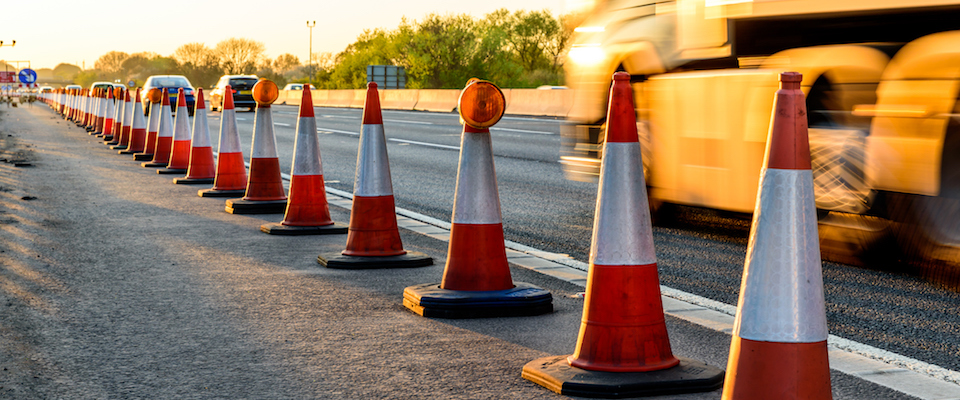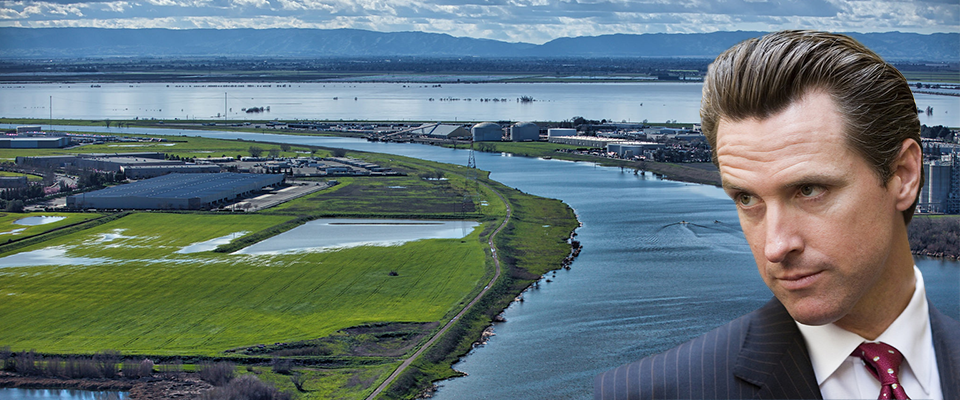The news cycle is spinning with such ferocity that it may be hard to remember that it was only a couple of weeks ago that infrastructure was Topic A, with the Trump administration announcing a new initiative to fix America’s potholed roads, repair its spavined bridges, and spiff up its energy delivery systems. But even while the general focus has shifted, Berkeley engineers and public policy analysts are thinking about possible remedies to our infrastructure woes.
David Wooley, a visiting professor at the UC Berkeley Goldman School of Public Policy and the executive director of the Center for Environmental Public Policy, says he can’t resist prefacing his observations with “a little critique” of Trump’s proposals, which are long on corporate participation and short on federal support.
“When you get down to it, it’s nothing but crazy rhetoric,” says Wooley. “He wants to slash funding for the U.S. Army Corps of Engineers and state and local grants. He proposes spending a vast amount of money on new natural gas pipelines, but from my perspective there’s no real public benefit—it’s designed to enhance corporate shareholder value. Meanwhile, he wants to spend $700 billion on defense. It just doesn’t make sense, especially for citizens on the ground who need some critical leadership on infrastructure.”
Not that flawed government infrastructure initiatives are anything new, says Wooley. Back in 2005, the Bush administration proposed building 150 new coal-fired power plants. “Thank goodness that didn’t happen,” he says.
Infrastructure typically stays on the back burner until an acute crisis like Flint, Michigan water contamination generates momentary interest and an ad hoc response.
Wooley has his own ideas about infrastructure, especially the electrification of the nation’s vehicle fleet. Steady progress on that is happening, he observes, particularly in California. But it shouldn’t be restricted to passenger cars, he emphasizes. Heavy-duty transport vehicles should also move to electrification, he says, particularly in congested urban areas.
“The Center for Environmental Public Policy is supporting a project to reduce air pollution at the Port of Oakland by gradually shifting from diesel to electricity for their trucks and heavy equipment,” says Wooley. Along with cutting pollution, other benefits can be realized by the move, including improving the port’s economic competitiveness and shrinking its carbon footprint by reducing the consumption of diesel fuel and other petroleum products, according to Wooley. Such projects make particular sense for states that rely on renewable energy sources or nuclear power generation rather than fossil fuels, and can be applied to any large industrial complex, not just ports.
“But to really get things going, government needs to provide incentives, and sustain them over multiple years. You need a long-term commitment for that kind of infrastructure transformation,” Wooley says.
Berkeley civil and environmental engineering professor Arpad Horvath also bemoans the lack of sustained political focus on infrastructure. The subject typically stays on the back burner, says Horvath, until an acute crisis like the Flint, Michigan water contamination generates momentary interest and an ad hoc response.“Then everything fades into the background again,” he observes.
“The one time we pay concentrated attention to it is during a major financial crisis, like the 2008 recession,” Horvath says, “because then it’s seen as an opportunity for investment and economic stimulus. But it should always be on the agenda, because systems are always deteriorating.”
The biggest bang for the infrastructure investment buck doesn’t necessarily come from new projects—it’s from dreary, prosaic old maintenance.
Horvath says that infrastructure planning in the U.S. is invariably narrow and inadequate, and that Trump’s proposals exemplify this flaw. Most policy makers, he says, are interested solely in shovel-ready projects, a proclivity that more often than not wastes vast amounts of money without resolving bedrock problems.
“That’s simply too opportunistic,” Horvath says. “We need a deliberate approach: identifying the biggest external costs to society and then tackling them in a rational way, as opposed to saying ‘Here’s $200 billion for roads.’ Unfortunately, politicians want to cut ribbons on new highways more than they want to study and identify our most pressing needs.”
In fact, says Horvath, the biggest bang for the infrastructure investment buck doesn’t necessarily come from new projects—it’s from dreary, prosaic old maintenance.
“It’s not sexy, it’s not appealing, but you have to repair the potholes, fix the leaky pipes, and replace aging fossil-fuel power plants,” Horvath says. “That can make a tremendous difference for millions of people.”
Scott Moura, a Berkeley assistant professor of energy, civil engineering, and climate systems, studies the likely effects of possible electrification scenarios, the energy requirements for converting all of New York City’s taxi fleet to electric vehicles (EVs), for example. One thing he’s finding is that the grid may not be ready for the wholesale electrification that both and environmentalists and progressive economists are promoting.
Ambitious infrastructure overhauls are difficult in America because the country has neither a “command-and-control” political system nor a sense of unified national purpose.
“Say you’re a big food retailer or business park and you want to install EV charging stations for both your employees and customers,” Moura says. “We’ve determined that the transformers serving these businesses typically aren’t rated for EV loads. If Whole Foods, for example, installed EV chargers it triples their size from a utility’s standpoint. So they tell the business they have to upgrade, which could cost seven figures.”
That, Moura observes with some understatement, can induce concern from businesses because they need a guaranteed rate of return to justify such outlay. To help businesses over that hump, Moura and researchers in his lab are developing software that allows builders to determine the number of EV chargers their projects can handle and to manage energy flow to the stations, ideally implementing sustainable means of power generation and storage such as solar panels and batteries.
Moura says that highly ambitious infrastructure overhauls are difficult in America because the country has neither the “command-and-control” political system of China nor the sense of unified national purpose that characterized the U.S. in the 1950s and early 1960s. So a decentralized approach, he says, might be more effective, microgrids being a case in point.
“Solar panels and battery storage are getting down in cost to the point that we can think of energy infrastructure in new and really interesting ways,” Moura says. “In large cities, you might have a block or several blocks served by a community solar power and storage system. It could even extend to shared EVs. That could result in a system that’s far less vulnerable to grid disruptions caused by natural disasters such as the hurricanes that hit the southern states and Puerto Rico.”
Jeff Vincent (Ph.D., Berkeley, city and regional planning), the deputy director and cofounder of Cal’s Center for Cities & Schools, castigates Trump’s proposals because they flip funding for many projects. Typically, the federal government shells out 80 percent of costs for major infrastructure projects—such as highways and water systems—while states contribute 20 percent. Trump proposes the inverse, making states cough up 80 percent while the feds contribute 20 percent.
A critically failing part of America’s infrastructure is public schools. On the campaign trail, Trump promised to rebuild public schools, but his recent proposals included no such plans.
“I just don’t see how the states can come up with that,” Vincent says. “Trump also is promoting the privatization of major public infrastructure. That could work for some projects in some sectors, but it’s unlike to address major infrastructure issues on a grand scale. The private sector won’t work for free, and many essential infrastructure projects aren’t configured to turn a profit.”
Moreover, infrastructure shouldn’t be viewed solely as roads and bridges, electricity grids, and water and sewage systems, Vincent says. A critical—and critically failing—part of America’s infrastructure is public schools. On the campaign trail, Vincent observed, Trump promised to rebuild public schools, but his recent proposals included no such plans.
“Schools should be a priority,” says Vincent, who has launched an initiative to rebuild school infrastructure, BuildUsSchools.org. “When you look at annual public expenditures by state and local entities, transportation is number one, schools are two, and everything else is a distant third. So [federal support] could be a huge job creator as well as a major boost to educational achievement. “
Berkeley civil engineering professor Kenichi Soga says infrastructure investments should be calibrated for the future, not the present. Further, Soga says, it isn’t necessarily a good idea to design infrastructure for a long shelf life, as has been the practice for decades. Designing a tunnel for a 120-year existence sounds good on the face of it, but cities are constantly changing, says Soga—growing, shrinking, shifting in economic underpinnings.
“A lot of things can change in 20 or 30 years, so you can end up with outdated infrastructure that really doesn’t properly serve needs,” says Soga, “so we should design our infrastructure with more resilience and less rigidity in mind.”
America’s infrastructure is old, in the way, and extremely expensive to remove and replace.
One way to achieve such “adaptable” infrastructure is to embed it with sensors. Combined with citizens equipped with smart phones, such a responsive infrastructure can provide a constant flow of critical data on traffic and water and power demands and stresses, indicating what needs to be fixed, replaced, or expanded—and when.
“The cost of aging infrastructure is high,” Soga says. “Living with something for 100 years can be a real social and economic burden. So [a sensor-rich environment] would let us develop better models, from the regional scale to street level. We could quantify and predict value better, identify what needs to be done, and provide real justification for major projects to communities and the government.”
Indeed, the infrastructure that once made America great is the infrastructure that is now hobbling it, says Horvath. It’s old, in the way, and extremely expensive to remove and replace. China is able to build new infrastructure at a meteoric pace not simply because of an autocratic political system, but because it didn’t have much infrastructure to begin with. Not much had to be torn out to make way for the new stuff.
“The investment we need to make is much different than the one the Chinese are making,” says Horvath. “It’s much easier to put in a high-speed rail where there’s no existing rail system. Here in the U.S., especially in California, everything is already built out. We’re dealing with legacy systems—brownfields. In China, it’s mostly greenfields. And when it comes to construction, brownfields are much harder than greenfields.”





















